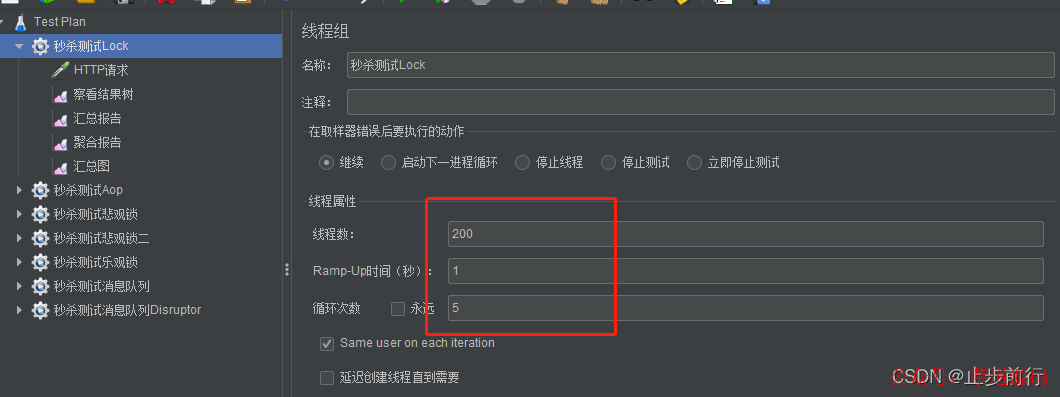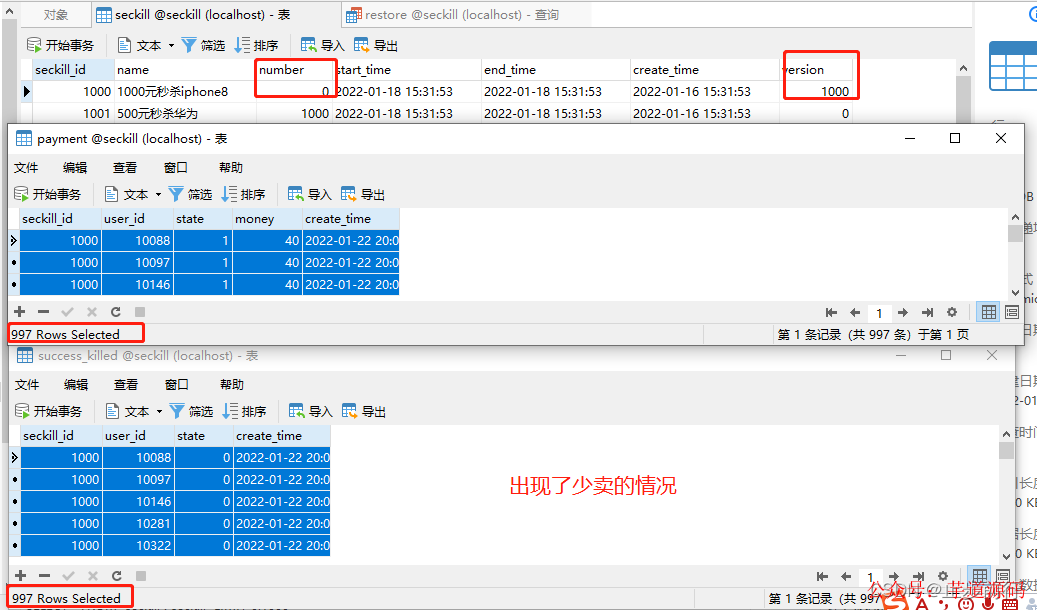

通过秒杀商品来模拟高并发的场景
电子说
描述
1.引言
高并发场景在现场的日常工作中很常见,特别是在互联网公司中,这篇文章就来通过秒杀商品来模拟高并发的场景。文章末尾会附上文章的所有代码、脚本和测试用例。
本文环境: SpringBoot 2.5.7 + MySQL 8.0 X + MybatisPlus + Swagger2.9.2
模拟工具: Jmeter
模拟场景: 减库存->创建订单->模拟支付
2.商品秒杀-超卖
在开发中,对于下面的代码,可能很熟悉:在Service里面加上@Transactional事务注解和Lock锁
控制层:Controller
@ApiOperation(value="秒杀实现方式——Lock加锁")
@PostMapping("/start/lock")
public Result startLock(long skgId){
try {
log.info("开始秒杀方式一...");
final long userId = (int) (new Random().nextDouble() * (99999 - 10000 + 1)) + 10000;
Result result = secondKillService.startSecondKillByLock(skgId, userId);
if(result != null){
log.info("用户:{}--{}", userId, result.get("msg"));
}else{
log.info("用户:{}--{}", userId, "哎呦喂,人也太多了,请稍后!");
}
} catch (Exception e) {
e.printStackTrace();
} finally {
}
return Result.ok();
}
业务层:Service
@Override
@Transactional(rollbackFor = Exception.class)
public Result startSecondKillByLock(long skgId, long userId) {
lock.lock();
try {
// 校验库存
SecondKill secondKill = secondKillMapper.selectById(skgId);
Integer number = secondKill.getNumber();
if (number > 0) {
// 扣库存
secondKill.setNumber(number - 1);
secondKillMapper.updateById(secondKill);
// 创建订单
SuccessKilled killed = new SuccessKilled();
killed.setSeckillId(skgId);
killed.setUserId(userId);
killed.setState((short) 0);
killed.setCreateTime(new Timestamp(System.currentTimeMillis()));
successKilledMapper.insert(killed);
// 模拟支付
Payment payment = new Payment();
payment.setSeckillId(skgId);
payment.setSeckillId(skgId);
payment.setUserId(userId);
payment.setMoney(40);
payment.setState((short) 1);
payment.setCreateTime(new Timestamp(System.currentTimeMillis()));
paymentMapper.insert(payment);
} else {
return Result.error(SecondKillStateEnum.END);
}
} catch (Exception e) {
throw new ScorpiosException("异常了个乖乖");
} finally {
lock.unlock();
}
return Result.ok(SecondKillStateEnum.SUCCESS);
}
对于上面的代码应该没啥问题吧,业务方法上加事务,在处理业务的时候加锁。
但上面这样写法是有问题的,会出现超卖的情况,看下测试结果:模拟1000个并发,抢100商品


这里在业务方法开始加了锁,在业务方法结束后释放了锁。但这里的事务提交却不是这样的,有可能在事务提交之前,就已经把锁释放了,这样会导致商品超卖现象。所以加锁的时机很重要!
3. 解决商品超卖
对于上面超卖现象,主要问题出现在事务中锁释放的时机,事务未提交之前,锁已经释放。(事务提交是在整个方法执行完)。如何解决这个问题呢,就是把加锁步骤提前
可以在controller层进行加锁
可以使用Aop在业务方法执行之前进行加锁
3.1 方式一(改进版加锁)
@ApiOperation(value="秒杀实现方式——Lock加锁")
@PostMapping("/start/lock")
public Result startLock(long skgId){
// 在此处加锁
lock.lock();
try {
log.info("开始秒杀方式一...");
final long userId = (int) (new Random().nextDouble() * (99999 - 10000 + 1)) + 10000;
Result result = secondKillService.startSecondKillByLock(skgId, userId);
if(result != null){
log.info("用户:{}--{}", userId, result.get("msg"));
}else{
log.info("用户:{}--{}", userId, "哎呦喂,人也太多了,请稍后!");
}
} catch (Exception e) {
e.printStackTrace();
} finally {
// 在此处释放锁
lock.unlock();
}
return Result.ok();
}
上面这样的加锁就可以解决事务未提交之前,锁释放的问题,可以分三种情况进行压力测试:
并发数1000,商品100
并发数1000,商品1000
并发数2000,商品1000
对于并发量大于商品数的情况,商品秒杀一般不会出现少卖的请况,但对于并发数小于等于商品数的时候可能会出现商品少卖情况,这也很好理解。
对于没有问题的情况就不贴图了,因为有很多种方式,贴图会太多

3.2 方式二(AOP版加锁)
对于上面在控制层进行加锁的方式,可能显得不优雅,那就还有另一种方式进行在事务之前加锁,那就是AOP
自定义AOP注解
@Target({ElementType.PARAMETER, ElementType.METHOD})
@Retention(RetentionPolicy.RUNTIME)
@Documented
public @interface ServiceLock {
String description() default "";
}
定义切面类
@Slf4j
@Component
@Scope
@Aspect
@Order(1) //order越小越是最先执行,但更重要的是最先执行的最后结束
public class LockAspect {
/**
* 思考:为什么不用synchronized
* service 默认是单例的,并发下lock只有一个实例
*/
private static Lock lock = new ReentrantLock(true); // 互斥锁 参数默认false,不公平锁
// Service层切点 用于记录错误日志
@Pointcut("@annotation(com.scorpios.secondkill.aop.ServiceLock)")
public void lockAspect() {
}
@Around("lockAspect()")
public Object around(ProceedingJoinPoint joinPoint) {
lock.lock();
Object obj = null;
try {
obj = joinPoint.proceed();
} catch (Throwable e) {
e.printStackTrace();
throw new RuntimeException();
} finally{
lock.unlock();
}
return obj;
}
}
在业务方法上添加AOP注解
@Override
@ServiceLock // 使用Aop进行加锁
@Transactional(rollbackFor = Exception.class)
public Result startSecondKillByAop(long skgId, long userId) {
try {
// 校验库存
SecondKill secondKill = secondKillMapper.selectById(skgId);
Integer number = secondKill.getNumber();
if (number > 0) {
//扣库存
secondKill.setNumber(number - 1);
secondKillMapper.updateById(secondKill);
//创建订单
SuccessKilled killed = new SuccessKilled();
killed.setSeckillId(skgId);
killed.setUserId(userId);
killed.setState((short) 0);
killed.setCreateTime(new Timestamp(System.currentTimeMillis()));
successKilledMapper.insert(killed);
//支付
Payment payment = new Payment();
payment.setSeckillId(skgId);
payment.setSeckillId(skgId);
payment.setUserId(userId);
payment.setMoney(40);
payment.setState((short) 1);
payment.setCreateTime(new Timestamp(System.currentTimeMillis()));
paymentMapper.insert(payment);
} else {
return Result.error(SecondKillStateEnum.END);
}
} catch (Exception e) {
throw new ScorpiosException("异常了个乖乖");
}
return Result.ok(SecondKillStateEnum.SUCCESS);
}
控制层:
@ApiOperation(value="秒杀实现方式二——Aop加锁")
@PostMapping("/start/aop")
public Result startAop(long skgId){
try {
log.info("开始秒杀方式二...");
final long userId = (int) (new Random().nextDouble() * (99999 - 10000 + 1)) + 10000;
Result result = secondKillService.startSecondKillByAop(skgId, userId);
if(result != null){
log.info("用户:{}--{}", userId, result.get("msg"));
}else{
log.info("用户:{}--{}", userId, "哎呦喂,人也太多了,请稍后!");
}
} catch (Exception e) {
e.printStackTrace();
}
return Result.ok();
}
这种方式在对锁的使用上,更高阶、更美观!
3.3 方式三(悲观锁一)
除了上面在业务代码层面加锁外,还可以使用数据库自带的锁进行并发控制。
悲观锁,什么是悲观锁呢?通俗的说,在做任何事情之前,都要进行加锁确认。这种数据库级加锁操作效率较低。
使用for update一定要加上事务,当事务处理完后,for update才会将行级锁解除
如果请求数和秒杀商品数量一致,会出现少卖
@ApiOperation(value="秒杀实现方式三——悲观锁")
@PostMapping("/start/pes/lock/one")
public Result startPesLockOne(long skgId){
try {
log.info("开始秒杀方式三...");
final long userId = (int) (new Random().nextDouble() * (99999 - 10000 + 1)) + 10000;
Result result = secondKillService.startSecondKillByUpdate(skgId, userId);
if(result != null){
log.info("用户:{}--{}", userId, result.get("msg"));
}else{
log.info("用户:{}--{}", userId, "哎呦喂,人也太多了,请稍后!");
}
} catch (Exception e) {
e.printStackTrace();
}
return Result.ok();
}
业务逻辑
@Override
@Transactional(rollbackFor = Exception.class)
public Result startSecondKillByUpdate(long skgId, long userId) {
try {
// 校验库存-悲观锁
SecondKill secondKill = secondKillMapper.querySecondKillForUpdate(skgId);
Integer number = secondKill.getNumber();
if (number > 0) {
//扣库存
secondKill.setNumber(number - 1);
secondKillMapper.updateById(secondKill);
//创建订单
SuccessKilled killed = new SuccessKilled();
killed.setSeckillId(skgId);
killed.setUserId(userId);
killed.setState((short) 0);
killed.setCreateTime(new Timestamp(System.currentTimeMillis()));
successKilledMapper.insert(killed);
//支付
Payment payment = new Payment();
payment.setSeckillId(skgId);
payment.setSeckillId(skgId);
payment.setUserId(userId);
payment.setMoney(40);
payment.setState((short) 1);
payment.setCreateTime(new Timestamp(System.currentTimeMillis()));
paymentMapper.insert(payment);
} else {
return Result.error(SecondKillStateEnum.END);
}
} catch (Exception e) {
throw new ScorpiosException("异常了个乖乖");
} finally {
}
return Result.ok(SecondKillStateEnum.SUCCESS);
}
Dao层
@Repository public interface SecondKillMapper extends BaseMapper{ /** * 将此行数据进行加锁,当整个方法将事务提交后,才会解锁 * @param skgId * @return */ @Select(value = "SELECT * FROM seckill WHERE seckill_id=#{skgId} FOR UPDATE") SecondKill querySecondKillForUpdate(@Param("skgId") Long skgId); }
上面是利用for update进行对查询数据加锁,加的是行锁
3.4 方式四(悲观锁二)
悲观锁的第二种方式就是利用update更新命令来加表锁
/**
* UPDATE锁表
* @param skgId 商品id
* @param userId 用户id
* @return
*/
@Override
@Transactional(rollbackFor = Exception.class)
public Result startSecondKillByUpdateTwo(long skgId, long userId) {
try {
// 不校验,直接扣库存更新
int result = secondKillMapper.updateSecondKillById(skgId);
if (result > 0) {
//创建订单
SuccessKilled killed = new SuccessKilled();
killed.setSeckillId(skgId);
killed.setUserId(userId);
killed.setState((short) 0);
killed.setCreateTime(new Timestamp(System.currentTimeMillis()));
successKilledMapper.insert(killed);
//支付
Payment payment = new Payment();
payment.setSeckillId(skgId);
payment.setSeckillId(skgId);
payment.setUserId(userId);
payment.setMoney(40);
payment.setState((short) 1);
payment.setCreateTime(new Timestamp(System.currentTimeMillis()));
paymentMapper.insert(payment);
} else {
return Result.error(SecondKillStateEnum.END);
}
} catch (Exception e) {
throw new ScorpiosException("异常了个乖乖");
} finally {
}
return Result.ok(SecondKillStateEnum.SUCCESS);
}
Dao层
@Repository public interface SecondKillMapper extends BaseMapper{ /** * 将此行数据进行加锁,当整个方法将事务提交后,才会解锁 * @param skgId * @return */ @Select(value = "SELECT * FROM seckill WHERE seckill_id=#{skgId} FOR UPDATE") SecondKill querySecondKillForUpdate(@Param("skgId") Long skgId); @Update(value = "UPDATE seckill SET number=number-1 WHERE seckill_id=#{skgId} AND number > 0") int updateSecondKillById(@Param("skgId") long skgId); }
3.5 方式五(乐观锁)
乐观锁,顾名思义,就是对操作结果很乐观,通过利用version字段来判断数据是否被修改
乐观锁,不进行库存数量的校验,直接做库存扣减
这里使用的乐观锁会出现大量的数据更新异常(抛异常就会导致购买失败)、如果配置的抢购人数比较少、比如120:100(人数:商品) 会出现少买的情况,不推荐使用乐观锁。
@ApiOperation(value="秒杀实现方式五——乐观锁")
@PostMapping("/start/opt/lock")
public Result startOptLock(long skgId){
try {
log.info("开始秒杀方式五...");
final long userId = (int) (new Random().nextDouble() * (99999 - 10000 + 1)) + 10000;
// 参数添加了购买数量
Result result = secondKillService.startSecondKillByPesLock(skgId, userId,1);
if(result != null){
log.info("用户:{}--{}", userId, result.get("msg"));
}else{
log.info("用户:{}--{}", userId, "哎呦喂,人也太多了,请稍后!");
}
} catch (Exception e) {
e.printStackTrace();
}
return Result.ok();
}
@Override
@Transactional(rollbackFor = Exception.class)
public Result startSecondKillByPesLock(long skgId, long userId, int number) {
// 乐观锁,不进行库存数量的校验,直接
try {
SecondKill kill = secondKillMapper.selectById(skgId);
// 剩余的数量应该要大于等于秒杀的数量
if(kill.getNumber() >= number) {
int result = secondKillMapper.updateSecondKillByVersion(number,skgId,kill.getVersion());
if (result > 0) {
//创建订单
SuccessKilled killed = new SuccessKilled();
killed.setSeckillId(skgId);
killed.setUserId(userId);
killed.setState((short) 0);
killed.setCreateTime(new Timestamp(System.currentTimeMillis()));
successKilledMapper.insert(killed);
//支付
Payment payment = new Payment();
payment.setSeckillId(skgId);
payment.setSeckillId(skgId);
payment.setUserId(userId);
payment.setMoney(40);
payment.setState((short) 1);
payment.setCreateTime(new Timestamp(System.currentTimeMillis()));
paymentMapper.insert(payment);
} else {
return Result.error(SecondKillStateEnum.END);
}
}
} catch (Exception e) {
throw new ScorpiosException("异常了个乖乖");
} finally {
}
return Result.ok(SecondKillStateEnum.SUCCESS);
}
@Repository
public interface SecondKillMapper extends BaseMapper {
/**
* 将此行数据进行加锁,当整个方法将事务提交后,才会解锁
* @param skgId
* @return
*/
@Select(value = "SELECT * FROM seckill WHERE seckill_id=#{skgId} FOR UPDATE")
SecondKill querySecondKillForUpdate(@Param("skgId") Long skgId);
@Update(value = "UPDATE seckill SET number=number-1 WHERE seckill_id=#{skgId} AND number > 0")
int updateSecondKillById(@Param("skgId") long skgId);
@Update(value = "UPDATE seckill SET number=number-#{number},version=version+1 WHERE seckill_id=#{skgId} AND version = #{version}")
int updateSecondKillByVersion(@Param("number") int number, @Param("skgId") long skgId, @Param("version")int version);
}
乐观锁会出现大量的数据更新异常(抛异常就会导致购买失败),会出现少买的情况,不推荐使用乐观锁
3.6 方式六(阻塞队列)
利用阻塞队类,也可以解决高并发问题。其思想就是把接收到的请求按顺序存放到队列中,消费者线程逐一从队列里取数据进行处理,看下具体代码。
阻塞队列:这里使用静态内部类的方式来实现单例模式,在并发条件下不会出现问题。
// 秒杀队列(固定长度为100)
public class SecondKillQueue {
// 队列大小
static final int QUEUE_MAX_SIZE = 100;
// 用于多线程间下单的队列
static BlockingQueue blockingQueue = new LinkedBlockingQueue(QUEUE_MAX_SIZE);
// 使用静态内部类,实现单例模式
private SecondKillQueue(){};
private static class SingletonHolder{
// 静态初始化器,由JVM来保证线程安全
private static SecondKillQueue queue = new SecondKillQueue();
}
/**
* 单例队列
* @return
*/
public static SecondKillQueue getSkillQueue(){
return SingletonHolder.queue;
}
/**
* 生产入队
* @param kill
* @throws InterruptedException
* add(e) 队列未满时,返回true;队列满则抛出IllegalStateException(“Queue full”)异常——AbstractQueue
* put(e) 队列未满时,直接插入没有返回值;队列满时会阻塞等待,一直等到队列未满时再插入。
* offer(e) 队列未满时,返回true;队列满时返回false。非阻塞立即返回。
* offer(e, time, unit) 设定等待的时间,如果在指定时间内还不能往队列中插入数据则返回false,插入成功返回true。
*/
public Boolean produce(SuccessKilled kill) {
return blockingQueue.offer(kill);
}
/**
* 消费出队
* poll() 获取并移除队首元素,在指定的时间内去轮询队列看有没有首元素有则返回,否者超时后返回null
* take() 与带超时时间的poll类似不同在于take时候如果当前队列空了它会一直等待其他线程调用notEmpty.signal()才会被唤醒
*/
public SuccessKilled consume() throws InterruptedException {
return blockingQueue.take();
}
/**
* 获取队列大小
* @return
*/
public int size() {
return blockingQueue.size();
}
}
消费秒杀队列:实现ApplicationRunner接口
// 消费秒杀队列
@Slf4j
@Component
public class TaskRunner implements ApplicationRunner{
@Autowired
private SecondKillService seckillService;
@Override
public void run(ApplicationArguments var){
new Thread(() -> {
log.info("队列启动成功");
while(true){
try {
// 进程内队列
SuccessKilled kill = SecondKillQueue.getSkillQueue().consume();
if(kill != null){
Result result = seckillService.startSecondKillByAop(kill.getSeckillId(), kill.getUserId());
if(result != null && result.equals(Result.ok(SecondKillStateEnum.SUCCESS))){
log.info("TaskRunner,result:{}",result);
log.info("TaskRunner从消息队列取出用户,用户:{}{}",kill.getUserId(),"秒杀成功");
}
}
} catch (InterruptedException e) {
e.printStackTrace();
}
}
}).start();
}
}
@ApiOperation(value="秒杀实现方式六——消息队列")
@PostMapping("/start/queue")
public Result startQueue(long skgId){
try {
log.info("开始秒杀方式六...");
final long userId = (int) (new Random().nextDouble() * (99999 - 10000 + 1)) + 10000;
SuccessKilled kill = new SuccessKilled();
kill.setSeckillId(skgId);
kill.setUserId(userId);
Boolean flag = SecondKillQueue.getSkillQueue().produce(kill);
// 虽然进入了队列,但是不一定能秒杀成功 进队出队有时间间隙
if(flag){
log.info("用户:{}{}",kill.getUserId(),"秒杀成功");
}else{
log.info("用户:{}{}",userId,"秒杀失败");
}
} catch (Exception e) {
e.printStackTrace();
}
return Result.ok();
}
注意:在业务层和AOP方法中,不能抛出任何异常, throw new RuntimeException()这些抛异常代码要注释掉。因为一旦程序抛出异常就会停止,导致消费秒杀队列进程终止!
使用阻塞队列来实现秒杀,有几点要注意:
消费秒杀队列中调用业务方法加锁与不加锁情况一样,也就是seckillService.startSecondKillByAop()、seckillService.startSecondKillByLock()方法结果一样,这也很好理解
当队列长度与商品数量一致时,会出现少卖的现象,可以调大数值
下面是队列长度1000,商品数量1000,并发数2000情况下出现的少卖

3.7.方式七(Disruptor队列)
Disruptor是个高性能队列,研发的初衷是解决内存队列的延迟问题,在性能测试中发现竟然与I/O操作处于同样的数量级,基于Disruptor开发的系统单线程能支撑每秒600万订单。
// 事件生成工厂(用来初始化预分配事件对象) public class SecondKillEventFactory implements EventFactory{ @Override public SecondKillEvent newInstance() { return new SecondKillEvent(); } } // 事件对象(秒杀事件) public class SecondKillEvent implements Serializable { private static final long serialVersionUID = 1L; private long seckillId; private long userId; // set/get方法略 } // 使用translator方式生产者 public class SecondKillEventProducer { private final static EventTranslatorVararg translator = (seckillEvent, seq, objs) -> { seckillEvent.setSeckillId((Long) objs[0]); seckillEvent.setUserId((Long) objs[1]); }; private final RingBuffer ringBuffer; public SecondKillEventProducer(RingBuffer ringBuffer){ this.ringBuffer = ringBuffer; } public void secondKill(long seckillId, long userId){ this.ringBuffer.publishEvent(translator, seckillId, userId); } } // 消费者(秒杀处理器) @Slf4j public class SecondKillEventConsumer implements EventHandler { private SecondKillService secondKillService = (SecondKillService) SpringUtil.getBean("secondKillService"); @Override public void onEvent(SecondKillEvent seckillEvent, long seq, boolean bool) { Result result = secondKillService.startSecondKillByAop(seckillEvent.getSeckillId(), seckillEvent.getUserId()); if(result.equals(Result.ok(SecondKillStateEnum.SUCCESS))){ log.info("用户:{}{}",seckillEvent.getUserId(),"秒杀成功"); } } } public class DisruptorUtil { static Disruptor disruptor; static{ SecondKillEventFactory factory = new SecondKillEventFactory(); int ringBufferSize = 1024; ThreadFactory threadFactory = runnable -> new Thread(runnable); disruptor = new Disruptor<>(factory, ringBufferSize, threadFactory); disruptor.handleEventsWith(new SecondKillEventConsumer()); disruptor.start(); } public static void producer(SecondKillEvent kill){ RingBuffer ringBuffer = disruptor.getRingBuffer(); SecondKillEventProducer producer = new SecondKillEventProducer(ringBuffer); producer.secondKill(kill.getSeckillId(),kill.getUserId()); } } @ApiOperation(value="秒杀实现方式七——Disruptor队列") @PostMapping("/start/disruptor") public Result startDisruptor(long skgId){ try { log.info("开始秒杀方式七..."); final long userId = (int) (new Random().nextDouble() * (99999 - 10000 + 1)) + 10000; SecondKillEvent kill = new SecondKillEvent(); kill.setSeckillId(skgId); kill.setUserId(userId); DisruptorUtil.producer(kill); } catch (Exception e) { e.printStackTrace(); } return Result.ok(); }
经过测试,发现使用Disruptor队列队列,与自定义队列有着同样的问题,也会出现超卖的情况,但效率有所提高。
4. 小结
对于上面七种实现并发的方式,做一下总结:
一、二方式是在代码中利用锁和事务的方式解决了并发问题,主要解决的是锁要加载事务之前
三、四、五方式主要是数据库的锁来解决并发问题,方式三是利用for upate对表加行锁,方式四是利用update来对表加锁,方式五是通过增加version字段来控制数据库的更新操作,方式五的效果最差
六、七方式是通过队列来解决并发问题,这里需要特别注意的是,在代码中不能通过throw抛异常,否则消费线程会终止,而且由于进队和出队存在时间间隙,会导致商品少卖
上面所有的情况都经过代码测试,测试分一下三种情况:
并发数1000,商品数100
并发数1000,商品数1000
并发数2000,商品数1000
思考:分布式情况下如何解决并发问题呢?下次继续试验。
审核编辑:刘清
-
消息队列的应用场景2020-06-23 2205
-
如何去实现一种基于SpringMVC的电商高并发秒杀系统设计2022-01-03 1450
-
ATC'22顶会论文RunD:高密高并发的轻量级 Serverless 安全容器运行时 | 龙蜥技术2022-09-05 7598
-
HarmonyOS如何使用异步并发能力进行开发2023-09-22 1145
-
如何通过多线程并发设计来提高应用程序的性能2019-09-28 5768
-
解密高并发业务场景下典型的秒杀系统的架构2021-11-17 2893
-
【源码版】基于SpringMVC的电商高并发秒杀系统设计思路2022-01-12 528
-
服务器的高并发能力如何提升?2023-03-17 1550
-
如何控制秒杀商品页面购买按钮的点亮2023-06-29 1745
-
工业物联网平台如何应对高并发应用场景2023-09-06 1083
-
java结合redis秒杀功能2023-12-04 1030
-
高并发系统的艺术:如何在流量洪峰中游刃有余2024-08-05 723
-
高并发物联网云平台是什么2024-08-13 801
-
TurMass™ 如何帮助解决 UWB 定位系统大规模终端标签高并发通信冲突问题?2025-03-17 823
全部0条评论

快来发表一下你的评论吧 !

